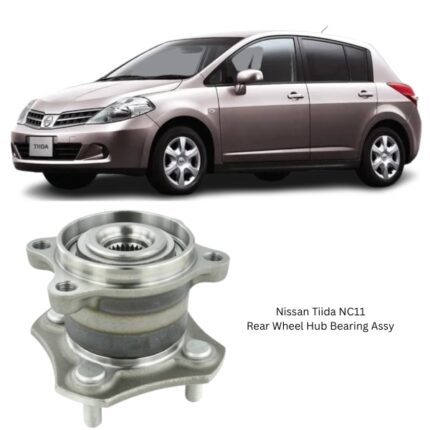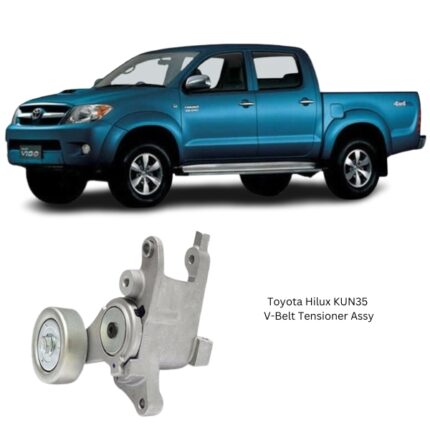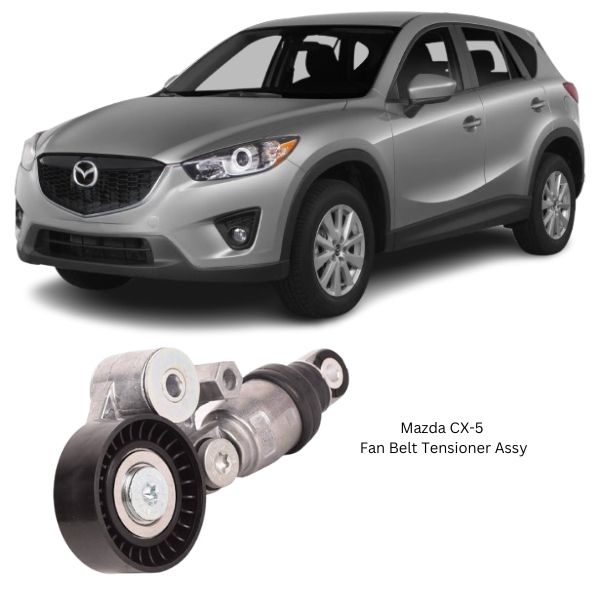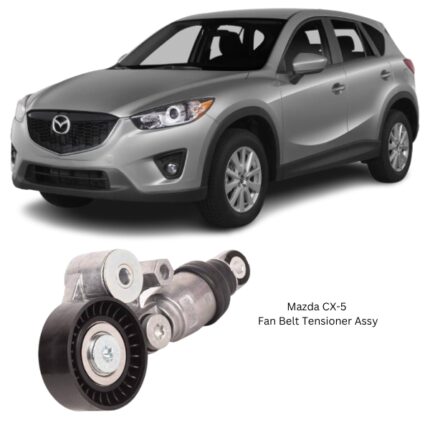Get Mazda CX-5 Fan Belt Tensioner Assy PE7W-15-980 in Kenya
The Fan Belt Tensioner Assembly, also referred to as a drive belt tensioner, is a critical component within the engine accessory drive system. It plays a fundamental role in maintaining optimal tension on the serpentine belt (or fan belt), which drives various engine accessories such as the alternator, water pump, power steering pump, and air conditioning compressor. A properly functioning tensioner ensures belt alignment, prevents slippage, reduces wear on connected components, and maintains consistent performance under varying engine loads and temperatures.
Purpose and Functional Overview
The core function of the fan belt tensioner assembly is to apply constant pressure to the fan belt, ensuring it remains tight and correctly aligned as it transmits power from the engine’s crankshaft pulley to other auxiliary components. Belt tension can fluctuate due to factors such as thermal expansion, engine vibration, and changes in load demand. Without active tension management, the belt would be prone to slipping, squealing, or even detachment—leading to failure of critical systems.
The tensioner assembly accommodates these changes automatically through either a spring-loaded or hydraulic mechanism, ensuring the fan belt remains in optimal contact with each pulley for efficient power transfer.
Design and Components
A standard fan belt tensioner assembly consists of several subcomponents engineered for strength, durability, and reliable performance under continuous motion and environmental stress:
1. Tensioner Arm
The arm is the main structural component that pivots on a fixed axis. Made from cast aluminum or high-strength steel, it transfers force from the internal spring or damping mechanism to the pulley. The arm must withstand continuous vibration, torque, and lateral loading while maintaining precision movement over the belt’s operating life.
2. Pulley
Mounted on the free end of the tensioner arm, the pulley maintains direct contact with the serpentine belt. It is commonly made of steel or a fiber-reinforced polymer and may contain a sealed ball bearing for smooth rotation. The surface of the pulley is typically grooved (for ribbed belts) or smooth (for backside contact), depending on belt routing.
3. Spring Mechanism
The spring mechanism, housed within the body of the tensioner, applies the necessary preload to the arm. It may be a coil spring or a flat spiral spring, depending on design. This component ensures that the arm and pulley continuously apply force to keep the belt tensioned correctly, even as it stretches over time.
4. Damping System
Some tensioners include hydraulic or friction-based damping elements. These components reduce belt vibration and flutter (oscillation) during sudden torque changes, minimizing noise and prolonging belt life.
5. Mounting Base
This is the section of the assembly that bolts directly onto the engine block or accessory bracket. The mounting structure must align perfectly with the belt path to prevent misrouting, misalignment, or uneven wear.
6. Stop Pin or Limiter
Integrated within the design is often a mechanical limiter or stop pin that prevents overextension of the tensioner arm, protecting the spring and pulley from damage in the event of belt failure or dislodgement.
Material Characteristics and Durability
Given its proximity to high temperatures and continuous mechanical stress, the Fan Belt Tensioner Assembly is constructed from high-performance materials engineered for longevity:
-
Housing & Arm Materials: Forged steel, die-cast aluminum, or cast iron, selected for their strength-to-weight ratio and corrosion resistance.
-
Pulley Materials: Thermoplastics with high heat resistance or zinc-coated steel for robust performance in high-friction environments.
-
Spring Composition: High-carbon steel or stainless steel, treated for fatigue resistance and corrosion protection.
-
Bearings: Precision-sealed ball bearings with high-temperature lubricants for extended rotational life and minimal maintenance.
These materials allow the assembly to endure the thermal cycling, oil exposure, water splash, and vibration inherent in the engine bay.
Mechanical Performance and Load Dynamics
The tensioner assembly must accommodate a range of mechanical forces:
-
Axial Load: The force pushing along the axis of the belt path as tension increases or decreases.
-
Radial Load: Side forces from belt movement or misalignment.
-
Rotational Load: Torque generated by rapid speed changes in belt-driven accessories.
-
Vibrational Load: Oscillations caused by engine firing pulses and accessory start/stop sequences.
Its spring and damping systems work together to maintain constant pressure while absorbing and compensating for these loads in real time.
Thermal and Environmental Considerations
The fan belt tensioner operates in a harsh environment. It is exposed to:
-
High Temperatures: From the engine block and radiant heat, requiring thermal stability and heat-resistant lubrication.
-
Contaminants: Such as dust, road grime, oil mist, and coolant spray, necessitating sealed bearing units and corrosion-resistant coatings.
-
Vibration: Continuous engine vibration and shock loads demand mechanical robustness and tight component tolerances.
Reliable function under these conditions is critical to avoiding premature tension loss or component failure.
Wear Indicators and Common Symptoms of Failure
While designed for extended service life, the fan belt tensioner assembly is a wear component and can degrade over time. Typical indicators of wear or failure include:
-
Squealing or Chirping Noises: Especially on startup or acceleration, often due to inadequate belt tension or bearing failure in the pulley.
-
Belt Slippage: Resulting in alternator undercharging, overheating, or steering difficulty.
-
Excessive Belt Wear: Including glazing, fraying, or cracking due to incorrect pulley alignment or improper tension.
-
Tensioner Arm Vibration or Flutter: Indicating a worn damping system or internal spring fatigue.
-
Pulley Misalignment: Visible wobble or deviation from the belt plane, often due to bearing or pivot joint wear.
Prompt inspection and replacement upon detection of these symptoms can prevent downstream component damage.
Installation and Maintenance Considerations
Proper installation is essential for effective operation:
-
Torque Specifications: Mounting bolts and pivot points must be tightened to manufacturer specifications to prevent flex or misalignment.
-
Belt Routing: Must follow the exact pattern to maintain the correct tension angles.
-
Pulley Condition: Should be free from scoring, wear, or rust before installation.
-
Spring Preload: In spring-loaded designs, the pre-tension must be released carefully to avoid damage or personal injury.
Once installed, the tensioner typically requires no routine maintenance, though periodic inspections during belt replacement or engine service are recommended.
Engineering Contribution to System Performance
The Fan Belt Tensioner Assembly directly influences several aspects of vehicle performance:
-
Accessory Efficiency: Maintains consistent power delivery to critical systems like the alternator and water pump.
-
Noise Reduction: Minimizes belt squeal and vibration-related noise through tension and damping.
-
Belt Longevity: Prolongs belt life by ensuring consistent load distribution and alignment.
-
System Reliability: Prevents sudden loss of accessory function by adapting to thermal expansion and belt wear.
A failing tensioner undermines the efficiency and reliability of all belt-driven systems, making it a vital component in vehicle operation.
Follow us on Facebook for more parts.





Reviews
Clear filtersThere are no reviews yet.